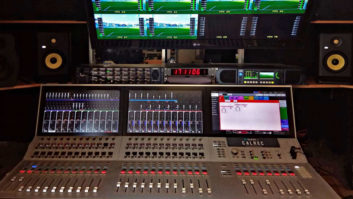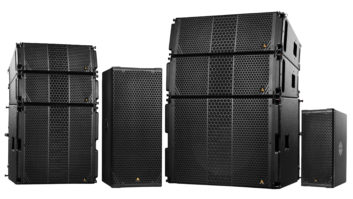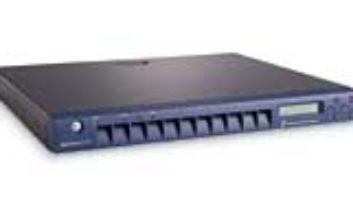OR WHY NETWORKS ARE BORN ANEWwas at a industry schmoozefest last night, meeting and greeting while munching on salmon thingies. Our small industry revolves around networking in every sense of the word. If successful, a business expands from one humble room to a multiroom facility with phone lines bringing clients and talent in from far away.
Most audio these days is numeric data, and data loves company. So it’s no wonder that, when you find computers, networks aren’t far behind. Local and wide area networks (LANs & WANs) have evolved from relatively slow, expensive and ungainly implementations to current cost-effective technologies that move bits at very satisfying speeds. Let’s take a look at the state of the art and how we got there.
NETWORKS OF YOREDue to budgetary constraints, sneakernet is still the “network” of choice, although trends in the IS industry have made true multi-user LAN-based production increasingly affordable. The first LAN product optimized for digital audio delivery was Sonic Solutions’ MediaNet. Introduced in 1993, it made available true multi-user storage for the first time in our industry. Boasting more than 4,500 seats at its peak, it leveraged the existing FDDI and CDDI standards. MediaNet employed a proprietary network file system and additions to the existing OSI reference model. These features provided bandwidth reservation for each node or user and guaranteed QoS (Quality of Service), shorthand for guaranteed sustained throughput.
At the time, other vendors sold 10 or 100BaseT as an alternative, yet even with 100BaseT’s effective data rate of 12 MBps on a good day, its lack of both multiuser access to a file and QoS guarantees meant that those products are really only good for background file transfers. Another historical choice was SCSI switches; but with SCSI’s infamous unreliability, I shudder to think of that technology as a long term solution.
Nowadays, sheer throughput compensates for lack of file locking or other seemingly essential file system features. ATM or Asynchronous Transfer Mode, a high-speed cell-switching transport standard favored by WAN architects, is one audio LAN solution offered by vendors. Although ATM is capable of getting the job done, its high cost, inability to guarantee delivery, tiny fixed frame length and sizable transmission overhead mean that it is best used for what it was designed for: enterprise backbones and WANs.
Another choice for network transport is Ethernet. The recent replacement of stodgy old Ethernet with amazing new Ethernet, commonly known as Gigabit Ethernet, allows portions of existing wiring to be used in many instances. Though upgrading to Gigabit Ethernet means replacing individual network interfaces, routers and switches, this technology is a sensible alternative to swapping an entire infrastructure, especially for background transfers.
THE NEW NETWORK MODELSLike the softening of the boundary between professional and consumer, the distinction is blurring between local and remote, storage and interconnect, network and bus. A new chimera is increasingly being seen in critical production environments: a SAN or Storage Area Network. And SANs will transform the way new media producers work.
To talk about SAN, we need to understand its roots: What happens when you attach your hard disks directly to a network interface instead of a networked server? You have NAS or Network Attached Storage. NAS eliminates unreliable cables and termination, surely the weak spot in any SCSI installation. It also frees up server resources and can interoperate with multiple operating systems and platforms. A good example of an inexpensive NAS appliance is Quantum. com’s Snap Server: It supports Microsoft, Novell, Mac and UNIX NFS file systems, covering most small studio configurations. Just hang it off of a 10 or 100BaseT network and voila, it autonegotiates an IP address assignment if a DHCP, BOOTP or RARP server is available.
Unfortunately, NAS suffers from the same network bottlenecks that hobble traditional topologies, bandwidth limitations and the high processing overhead required for packetizing and serializing the usually parallel SCSI data. Done well, NAS provides high performance, highly available, expandable storage. Done poorly, it simply delays the inevitable need to manage your storage budget, degrades network performance and greatly increases administration costs. (Consider the additional network traffic and administration costs that backing up a simple 40GB NAS would require.) So, think of NAS as “starter” technology, easing the transition to SAN and interoperating comfortably with it.
SANs replace the traditional client/server and simple NAS models with a high-availability, “storage-centric” local or remote network that directly connects storage, servers and clients. SANs are designed as networks that are dedicated to storage transactions, making that storage equally available to all users, all the time at rated bandwidth. A separate, parallel messaging network (usually the existing primary network) carries other traffic like TELNET or those SNMP and HTTP transactions that we all know and love.
To give you some idea of how this fits into your microcosm, consider a typical two- or three-room facility: The LAN would usually have 100BaseT connecting DAWs, with all traffic flowing around that network and 16/44.1 stereo user traffic. Segregating the storage on a SAN would remove all of the user traffic from the LAN and increase throughput by at least a factor of 10.
The current king of heteroconnections is Fibre Channel (FC), the most common choice for transport in SAN implementations. More than a network, it’s a way of life! Fibre Channel is a data management system, a unified approach to storage, network and control. It provides accessible supervision, scalable performance and versatile connectivity, via simple point-to-point topologies with dedicated bandwidth or loops with shared bandwidth.
For wicked fast connections with scalable bandwidth and greater reliability, switched connections are the way to go. They provide reliable QoS of more than 1 Gbits/s, with support for distances up to 10 km. (Neither FireWire nor Ethernet supports QoS, so end-to-end latency is an unknown variable with those delivery schemes. And that is potentially devastating for real-time network delivery of audio or video.)
Another selling point for FC is scalability. From point-to-point links at gigabit speeds to fabrics with multiple switches, FC delivers unmatched performance. Its congestion-free, credit-based flow control delivers data as fast as the destination buffer is able to receive it. And, FC has very little transmission overhead.
The chemical wedding of Fibre Channel and cost-effective WAN standards like xDSL promise to transform the soul of Squire SAN. What was once a local storage network can now become as wide and far-reaching as your pockets are deep. Alas, we aren’t all Michael Eisner, but we may benefit from another disturbance in the storage force. With the recent introduction of FireWire-attached NAS, you can have some of the benefits of both NAS and SANs. Micronet.com’s groovy SANcube segregates the storage traffic on a plug-and-chug FireWire host bus and provides 30 MB/s availability for up to four simultaneous users. (And, it’s got great LEDs to stare at when those guitar overdubs aren’t going so good.) However, the administration burden would still be shouldered by an existing (Ethernet) LAN, whereas a full-blown SAN would provide both user access and backup via the Fibre Channel conduit. Remember, backup and management must be factored in to any Total Cost of Ownership equation.
Although the old stuff works just fine, SAN and Fibre Channel are easing the burden of engineering and maintaining high-performance production systems. Tight budgets being the norm, this technology will take a year or so to filter down to the average punter’s level. But, one must plan for tomorrow. So, in the months to come, I’ll be looking at other advanced storage issues and future standards such as InfiniBand. If you’d like more information on SANs and Fibre Channel, drop by seneschal.net and check out the SAN links I’ve collected for you. For your part, crank up your mail client and let me know what occupies your thoughts. Send your ramblings to thebitstream@seneschal.net, and keep networking.
THIRD ANNUAL MP3 SUMMIT NEXT MONTHThe third annual MP3 Summit, hosted by MP3.com, will take place June 20-21 at the University of California San Diego. This year’s show features the MSP Pavilion, showcasing music service providers. There is limited free MSP Pavilion space available; for information on securing space, or to find out more about conference exhibits, panels and seminars, visit www.mp3.com/summit.
REALNETWORKS FORMS ALLIANCES WITH AUDIOSOFT, MJUICE.COM, MICROSOFTRealNetworks Inc. (www.real.com) has signed a development agreement with AudioSoft, a developer of Internet-based digital copyright management for the music industry. Under the agreement, AudioSoft will integrate its digital copyright management technology (which includes a service that provides both accurate and real time reporting of playlists for the copyright collection societies) onto the RealSystem G2 platform. RealNetworks has also made an agreement with MP3 distributor Mjuice.com to make Mjuice’s catalog of more than 30,000 secure music tracks available to more than 23 million RealJukebox users. In other RealNetwork News, Microsoft announced that RealNetwork will license Microsoft Windows Media audio and video technology.





